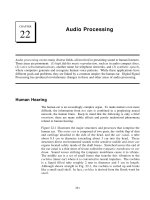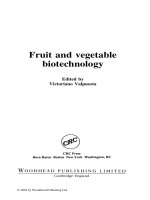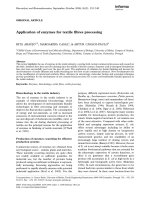Orange fruit processing
Bạn đang xem bản rút gọn của tài liệu. Xem và tải ngay bản đầy đủ của tài liệu tại đây (100.11 KB, 31 trang )
Orange Fruit Processing
Luis Cisneros-Zevallos, Ph.D.
Department of Horticultural Sciences
Texas A&M University
Commercially Important Orange
Varieties
• Valencia - most widely grown, late
maturing, good for FCOJ
• Pineapple - mid season maturing, good
fresh &processing qualities
• Hamlin - early maturing, beats the freeze
• Pera - late maturing, most popular in
Brazil
Fruit Quality Factors
•
•
•
•
•
•
Soluble solids
Acidity
Brix/acid ratio
Juice color
Low level of bitter compounds
Good flavor
Juice Categories
•
•
•
•
Fresh unpasteurized
FCOJ
Chilled orange juice
Canned orange juice
Fresh Unpasteurized Juice
• Minimal treatment after extraction before
packaging and distribution
• Excellent flavor, but shelf life < 3 days
• Must be stored at < 10C, preferably cooler
Preparation for Processing
Washing
Sorting
Fresh
Fungicide/wax
Processe
d
Extractor
Frozen Concentrated Orange Juice
(FCOJ)
• Developed 1940’s
• Initial product had poor flavor & color
• Development of high vacuum, low temperature
evaporator improved quality
• Concentrate was added to a small quantity of
fresh “cut back” juice to restore flavor & aroma
lost during concentration
Frozen Concentrated Orange
Juice (FCOJ)
• Original low temperature evaporators have
been replaced by:
A) multi-effect, multi-stage, high
temperature, short time evaporators
B) thermally accelerated short time
evaporators (TASTE)
• Volatile aroma & flavors compounds are
collected (aqueous essence or essence
oil)
Concentrating Juices
3-effect thermal
evaporator
1
Pulp discharge as
cake or slurry for later
reconstitution
2-effect thermal
evaporator
Clarified serum
Centrifuge
Concentrated serum
for subsequent
reconstitution
2
Hyperfiltration
Single strength juice
3
Hyperfiltration
Multiple- (two-) effect evaporator
V2
V1
S1
F2
C2
F1
C1
P1
P2
Frozen Concentrated Orange Juice
(FCOJ)
• Juices of various origin are concentrated &
stored in refrigerated tanks
• Frozen concentrates are blended to achieve
desired final product
• Flavor is restored by addition of peel oil &
essence
• Blend is packaged & distributed in frozen form
Chilled Orange Juice
• Fresh juice - pasteurized, either hot filled or
aseptically filled after cooling into sterile
containers
• Blending to achieve uniform quality
• FCOJ - juice is reconstituted, pasteurized &
peel oil added for flavor, then filled into sterile
packages
Package Considerations
• Glass - deterioration of color, flavor and
loss of ascorbic acid
• Plastic containers or plastic lined cartons
- orange flavor compounds migrate into
the plastic container or container liner
Canned Orange Juice
• Produced by reconstituting FCOJ or
blending juices from several varieties
• Steps involved:
Deaeration
Deoiling
Pasteurization
Canning
A.
B.
C.
D.
Juice Deaeration
• Reduces levels of dissolved oxygen
• Reduces flavor deterioration
• Prevents degradation of ascorbic acid
• Reduces frothing during the filling step
Juice Deoiling
• Controls the peel oil level of freshly
extracted juices prior to packaging
• Performed under vacuum with the
application of mild heat to produce vapors
which remove about 90% of the volatile
peel oil
• U.S. standards specify an upper limit for
peel oil content (limonene)
Juice Pasteurization
• Required to inactivate enzymes and destroy
microbial contaminants
• Inactivate PME to stabililize cloud
• Juice is rapidly heated to 92C in tubular or
plate heat exchangers and held for 30 sec
• Juice is then pumped into filler tanks and
rapidly filled into cans
Juice Canning
• After filling, live steam is injected into the
headspace followed by closing of the can
• Cans are inverted to sterilize the inside of the lid
and cooled as they are conveyed
• Cans emerge with some residual heat to facilitate
drying, thereby preventing rusting
• Plain tinned or enameled cans are typically used
to prevent discoloration and loss of ascorbic acid
Processing By-Products
• Orange flavor volatiles - aqueous essence,
used for flavoring purposes
• Orange peel oils - cold pressed oil, used
for flavoring purposes
• Water extracted soluble solids (WESOS)
or pulp wash - used for beverages
• Waste products - animal feed, flavonoids,
pectin
Spray Drier
Feed in
Air in
Product out
Fruit Sections
• Manual sections - Cold peel method where
the peel & outer membrane is sliced off
manually with a knife, or hot peel method
where the peel is subjected to steam scalding
or hot water immersion
• Sections are separated with knife from the
peeled fruit, followed by packing into
containers in juice or light syrup
Syrup for Refrigerated Grapefruit
Sections
• 12 - 15 Brix
• Citric acid (0.5 - 1%)
• Potassium sorbate and sodium
benzoate (0.1% each)
• 30 day shelf life when stored at < 40F
Fruit Sections
• New system - Vacuum infusion of hot
water or pectic enzyme solutions into
scored grapefruit peel
• Peel is easily removed and yield of
sections is greatly improved
• Sections may be treated with calcium salts
& edible coatings to improve quality
• Packaged in modified atmosphere films
21
Strawberry
CO2%
15
Cherry
10
Mango, papaya, pineapple
Grapefruit
5
0
Banana
Orange
Grape
0
5
10
O2 %
15
21
Plastic film
Area
Volume
Permeability O2
Permeability
CO2
Thickness
Produce
Weight
Oxygen uptake
CO2 production
The MAP System
CO2i
O2i
CO2e
O2e




![Digital Image Processing CHAPTER 09 [GONZALEZ R C WOOD]](https://media.store123doc.com/images/document/12/ve/zi/medium_VEJp13hIrs.jpg)




